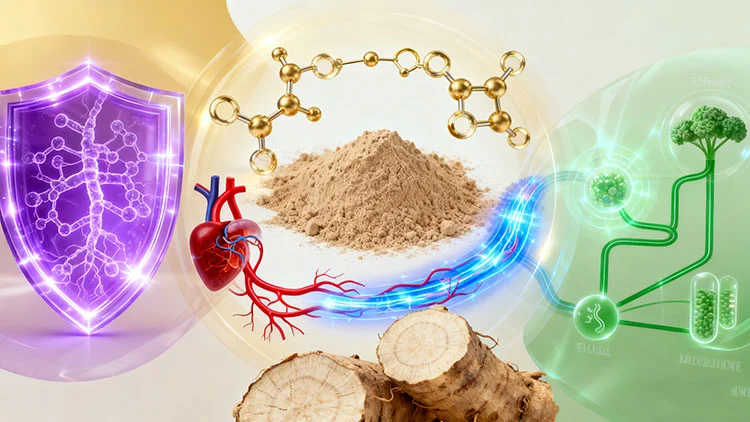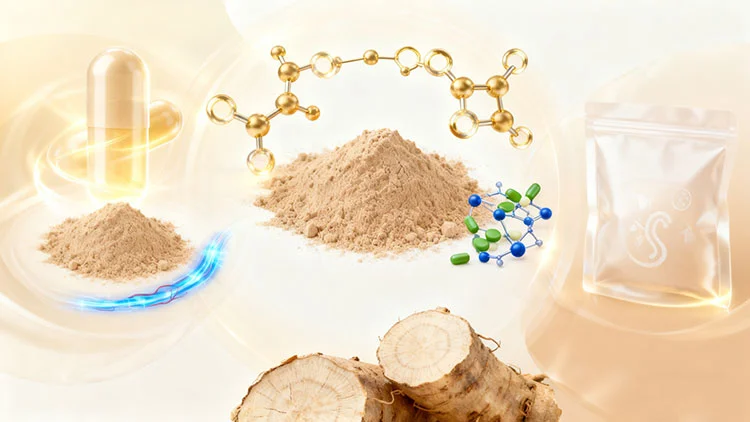Pueraria Lobata Powder: Composition, Key Flavonoids & Functional Benefits
Pueraria lobata, commonly known as kudzu root, has been a staple in traditional Chinese medicine for centuries. In recent years, its powdered form has gained significant attention in the nutraceutical industry due to its rich phytochemical profile and potential health benefits. Pueraria lobata powder is derived from the root of the kudzu plant and is packed with bioactive compounds, particularly isoflavones and other flavonoids. These compounds are known for their potent antioxidant, anti-inflammatory, and hormone-modulating properties. As the demand for natural health solutions continues to grow, Pueraria lobata powder has emerged as a versatile ingredient in functional foods, dietary supplements, and even cosmetic formulations. This blog post delves into the composition of Pueraria lobata powder, explores its key flavonoids, and examines the functional benefits that make it a compelling option for health-conscious consumers and product formulators alike.
Understanding the Phytochemical Profile of Pueraria Lobata Powder: Isoflavones, Flavonoids & More
Isoflavone Content and Diversity
Pueraria lobata powder is renowned for its high isoflavone content, which forms the cornerstone of its phytochemical profile. The primary isoflavones found in this powder include puerarin, daidzin, and genistin. Puerarin, in particular, is unique to Pueraria lobata and can constitute up to 12% of the dried root weight. This compound is notable for its rapid absorption and bioavailability, making it a key contributor to the powder's health benefits. Daidzin and genistin, along with their aglycone forms daidzein and genistein, are also present in significant quantities. These isoflavones are known for their estrogenic and antioxidant activities, which contribute to the powder's potential effects on hormonal balance and cellular protection.
Other Flavonoids and Phenolic Compounds
Beyond isoflavones, Pueraria lobata powder contains a diverse array of other flavonoids and phenolic compounds. These include formononetin, biochanin A, and various glycosides of these compounds. The powder also contains significant amounts of tectoridin and 6"-O-xylosyl-tectoridin, which are less common flavonoids with potential health benefits. Phenolic acids such as p-coumaric acid and ferulic acid are present as well, contributing to the overall antioxidant capacity of the powder. This rich flavonoid profile enables Pueraria lobata powder to offer a broad spectrum of biological activities, making it a valuable ingredient in health-promoting formulations.
Nutritional Components and Trace Elements
In addition to its flavonoid content, Pueraria lobata powder is a source of various nutritional components and trace elements. The powder contains dietary fiber, which can support digestive health and contribute to feelings of satiety. It also provides small amounts of essential minerals such as potassium, calcium, and magnesium. Trace elements like zinc and selenium, while present in minute quantities, may contribute to the overall nutritional value of the powder. These nutritional aspects, combined with the bioactive phytochemicals, make Pueraria lobata powder a multifaceted ingredient that can support various aspects of health and wellness when incorporated into a balanced diet or supplement regimen.

How Key Flavonoids in Pueraria Lobata Powder Support Antioxidant, Circulatory and Metabolic Health
Antioxidant Properties and Cellular Protection
The flavonoids in Pueraria lobata powder, particularly puerarin and other isoflavones, exhibit potent antioxidant properties. These compounds act as scavengers of free radicals, helping to neutralize oxidative stress that can damage cellular structures and contribute to chronic diseases. Research has shown that the antioxidant activity of Pueraria lobata powder can help protect against lipid peroxidation and DNA damage. This protective effect extends to various tissues and organs, including the liver, heart, and brain. By incorporating Pueraria lobata powder into functional foods or supplements, formulators can offer products that support overall cellular health and potentially slow down age-related degenerative processes associated with oxidative stress.
Cardiovascular Benefits and Circulatory Support
Pueraria lobata powder has been extensively studied for its potential cardiovascular benefits. The isoflavones present in the powder, especially puerarin, have been shown to have vasodilatory effects, which can help improve blood flow and reduce blood pressure. Additionally, these compounds may help regulate lipid metabolism, potentially lowering total cholesterol and triglyceride levels while increasing HDL cholesterol. The antioxidant properties of Pueraria lobata powder also play a role in protecting the cardiovascular system by reducing oxidation of LDL cholesterol, a key factor in the development of atherosclerosis. Furthermore, some studies suggest that the flavonoids in Pueraria lobata powder may have antiplatelet effects, which could contribute to improved circulatory health and reduced risk of thrombosis.
Metabolic Health and Glucose Regulation
The flavonoids in Pueraria lobata powder have demonstrated potential benefits for metabolic health, particularly in the area of glucose regulation. Studies have shown that puerarin and other isoflavones may help improve insulin sensitivity and glucose uptake in cells. This effect could be beneficial for individuals with or at risk of type 2 diabetes. Moreover, Pueraria lobata powder has been associated with the activation of AMPK (AMP-activated protein kinase), an enzyme that plays a crucial role in cellular energy homeostasis and metabolism. By supporting healthy glucose metabolism and energy utilization, Pueraria lobata powder could be a valuable ingredient in formulations aimed at promoting metabolic health and weight management. The combination of these metabolic effects with its antioxidant and cardiovascular benefits makes Pueraria lobata powder a multifaceted ingredient for overall health support.

Formulation Insights: Integrating Pueraria Lobata Powder into Functional Foods and Supplements
Dosage Considerations and Bioavailability
When formulating with Pueraria lobata powder, determining the appropriate dosage is crucial for achieving optimal health benefits while ensuring product safety. Typical dosages in supplements range from 500 mg to 1500 mg per day, depending on the specific formulation and intended use. However, it's important to consider the concentration of active compounds, particularly isoflavones, in the powder. Standardized extracts with known quantities of key flavonoids like puerarin can provide more consistent results. Bioavailability is another critical factor; while Pueraria lobata powder is generally well-absorbed, certain formulation techniques can enhance its efficacy. For instance, combining the powder with phospholipids or using advanced delivery systems like liposomes can potentially improve the absorption and bioavailability of its bioactive compounds, allowing for lower effective doses and potentially reducing any risk of side effects.
Compatibility with Other Ingredients
Pueraria lobata powder demonstrates good compatibility with a wide range of other ingredients, making it versatile for use in various formulations. It synergizes well with other antioxidants like vitamin C and E, potentially enhancing overall antioxidant activity in the final product. For cardiovascular health formulations, it can be combined with ingredients like CoQ10, omega-3 fatty acids, or hawthorn berry extract for complementary benefits. In metabolic health products, Pueraria lobata powder can be paired with chromium, alpha-lipoic acid, or berberine for enhanced glucose regulation support. When formulating functional foods, the powder's mild flavor profile allows it to be easily incorporated into beverages, protein shakes, or baked goods without significantly altering taste. However, formulators should be aware of potential interactions with certain medications, particularly those affecting blood clotting or hormone levels, and provide appropriate warnings on product labels.
Stability and Shelf-life Considerations
Ensuring the stability of Pueraria lobata powder in various formulations is essential for maintaining its efficacy throughout the product's shelf life. The isoflavones in the powder are generally stable under normal storage conditions, but exposure to heat, light, and moisture can degrade these compounds over time. To maximize stability, it's recommended to store Pueraria lobata powder and products containing it in cool, dry conditions and in opaque or light-resistant packaging. For liquid formulations, the pH of the solution can affect stability, with slightly acidic conditions often being optimal for preserving isoflavone content. Antioxidants like vitamin E or rosemary extract can be added to formulations to further protect against oxidation. When used in functional foods, the thermal stability of Pueraria lobata powder should be considered during processing, as high temperatures may degrade some of the active compounds. By carefully managing these factors, formulators can ensure that products containing Pueraria lobata powder maintain their potency and effectiveness throughout their intended shelf life.
Conclusion
Pueraria lobata powder emerges as a versatile and potent ingredient in the realm of natural health solutions. Its rich phytochemical profile, dominated by isoflavones and other flavonoids, offers a wide array of potential health benefits, particularly in the areas of antioxidant protection, cardiovascular support, and metabolic health. As research continues to unveil its mechanisms of action and potential applications, Pueraria lobata powder is likely to play an increasingly significant role in functional foods and dietary supplements. However, careful consideration of dosage, bioavailability, and formulation stability is crucial for maximizing its benefits. With proper integration and continued scientific exploration, Pueraria lobata powder stands poised to make substantial contributions to health and wellness products in the coming years.
For high-quality Pueraria lobata powder and expert formulation support, consider partnering with Shaanxi SCIGROUND Biotechnology Co., Ltd. As a leading manufacturer of plant extracts and health food ingredients, we offer premium Pueraria lobata powder and a range of other beneficial plant extracts. Our state-of-the-art facilities and commitment to quality ensure that you receive products of the highest standard. Whether you're looking to develop functional foods, dietary supplements, or cosmetic formulations, our team can provide tailored solutions to meet your needs. Contact us at info@scigroundbio.com to learn more about how we can support your product development goals with our extensive range of plant-based ingredients.
FAQ
Q: What is the main active compound in Pueraria lobata powder?
A: The main active compound in Pueraria lobata powder is puerarin, a unique isoflavone that can constitute up to 12% of the dried root weight.
Q: How does Pueraria lobata powder support cardiovascular health?
A: Pueraria lobata powder supports cardiovascular health through its vasodilatory effects, potential to regulate lipid metabolism, and antioxidant properties that protect against LDL oxidation.
Q: Can Pueraria lobata powder help with blood sugar control?
A: Yes, studies suggest that the flavonoids in Pueraria lobata powder may improve insulin sensitivity and glucose uptake in cells, potentially benefiting blood sugar control.
Q: What is the typical dosage range for Pueraria lobata powder in supplements?
A: The typical dosage range for Pueraria lobata powder in supplements is 500 mg to 1500 mg per day, depending on the formulation and intended use.
Q: How should Pueraria lobata powder be stored to maintain its efficacy?
A: Pueraria lobata powder should be stored in cool, dry conditions and in opaque or light-resistant packaging to protect its active compounds from degradation.
References
1. Wong, K. H., Li, G. Q., Li, K. M., Razmovski-Naumovski, V., & Chan, K. (2011). Kudzu root: Traditional uses and potential medicinal benefits in diabetes and cardiovascular diseases. Journal of Ethnopharmacology, 134(3), 584-607.
2. Keung, W. M., & Vallee, B. L. (1998). Kudzu root: An ancient Chinese source of modern antipsychotic agents. Phytochemistry, 47(4), 499-506.
3. Penetar, D. M., Toto, L. H., Farmer, S. L., Lee, D. Y., Ma, Z., Liu, Y., & Lukas, S. E. (2012). The isoflavone puerarin reduces alcohol intake in heavy drinkers: A pilot study. Drug and Alcohol Dependence, 126(1-2), 251-256.
4. Prasain, J. K., Peng, N., Rajbhandari, R., & Wyss, J. M. (2012). The Chinese Pueraria root extract (Pueraria lobata) ameliorates impaired glucose and lipid metabolism in obese mice. Phytomedicine, 20(1), 17-23.
5. Reppert, A., Yousef, G. G., Rogers, R. B., & Lila, M. A. (2008). Isolation of radiolabeled isoflavones from kudzu (Pueraria lobata) root cultures. Journal of Agricultural and Food Chemistry, 56(16), 7860-7865.
6. Zhang, Z., Lam, T. N., & Zuo, Z. (2013). Radix Puerariae: An overview of its chemistry, pharmacology, pharmacokinetics, and clinical use. Journal of Clinical Pharmacology, 53(8), 787-811.